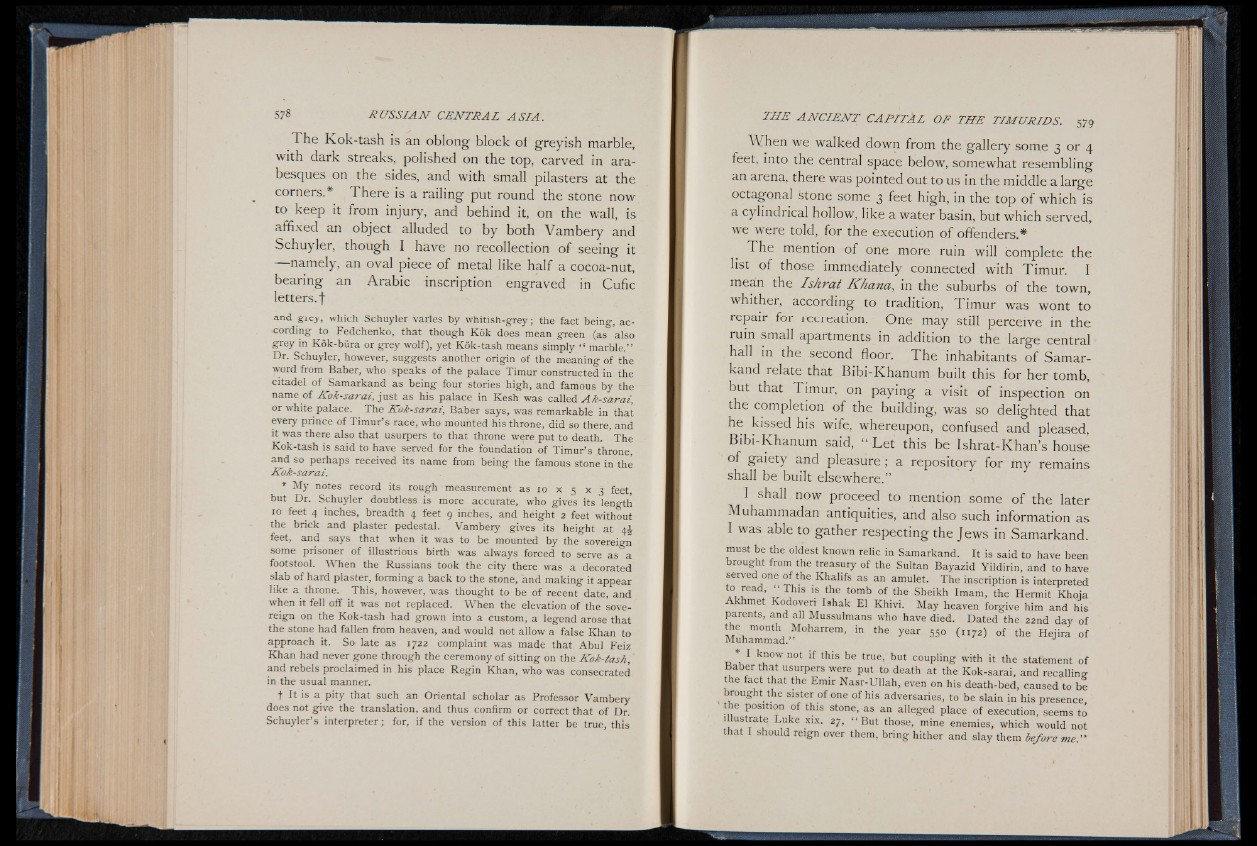
The Kok-tash is an oblong block oi greyish marble,
with dark streaks, polished on the top, carved in arabesques
on the sides, and with small pilasters at the
corners.* There is a railing put round the stone now
to keep it from injury, and behind it, on the wall, is
affixed an object alluded to by both Vambery and
Schuyler, though I have no recollection of seeing it
— namely, an oval piece of metal like half a cocoa-nut,
bearing an Arabic inscription engraved in Cufic
letters, f
and grey, which Schuyler varies by whitish-grey; the fact being, a c cording
to Fedchenko, that though Kok does mean green (as also
grey in Kok-bura or grey wolf), yet Kok-tash means simply “ marble.”
Dr. Schuyler, however, suggests another origin of the meaning of the
word from Baber, who speaks of the palace Timur constructed in the
citadel of Samarkand as being four stories high, and famous by the
name of Kok-sarai, just as his palace in Kesh was called Ak-sarai,
or white palace. The Kok-sarai, Baber says, was remarkable in that
every prince of Timur’ s race, who mounted his throne, did so there, and
it was there also that usurpers to that throne were put to death. The
Kok-tash is said to have served for the foundation of Timur’s throne,
and so perhaps received its name from being the famous stone in the
Kok-sarai.
* My notes record its rough measurement as 10 x 5 x 3 feet,
but Dr. Schuyler doubtless is more accurate, who gives its length
10 feet 4 inches, breadth 4 feet 9 inches, and height 2 feet without
the brick and plaster pedestal. Vambeiy gives its height at 4^
feet, and says that when it was to be mounted by the sovereign
some prisoner of illustrious birth was always forced to serve as a
footstool. When the Russians took the city there was a decorated
slab of hard plaster, forming a back to the stone, and making it appear
like a throne. This, however, was thought to be of recent date, and
when it fell off it was not replaced. When the elevation of the sovereign
on the Kok-tash had grown into a custom, a legend arose that
the stone had fallen from heaven, and would not allow a false Khan to
approach it. So late as 1722 complaint was made that Abul Feiz
Khan had never gone through the ceremony of sitting on the Kok-tash,'
and rebels proclaimed in his place Regin Khan, who was consecrated
in the usual manner.
t It is a pity that such an Oriental scholar as Professor Vambeiy
does not give the translation, and thus confirm or correct that of Dr.
Schuyler’ s interpreter; for, if the version of this latter be true, this
When we walked down from the gallery some 3 or 4
feet, into the central space below, somewhat resembling
an arena, there was pointed out to us in the middle a large
octagonal stone some 3 feet high, in the top of which is
a cylindrical hollow, like a water basin, but which served,
we were told, for the execution of offenders.*
The mention of one more ruin will complete the
list of those immediately connected with Timur. I
mean the Ishrat Khana, in the suburbs of the town,
whither, according to tradition, Timur was wont to
repair for recreation. One may still perceive in the
ruin small apartments in addition to the large central
hall in the second floor. The inhabitants of Samarkand
relate that Bibi-Khanum built this for her tomb,
but that Timur, on paying a visit of inspection on
the completion of the building, was so delighted that
he kissed his wife, whereupon, confused and pleased,
Bibi-Khanum said, “ Let this be Ishrat-Khan’s hous^
of gaiety and pleasure; a repository for my remains
shall be built elsewhere.”
I shall now proceed to mention some of the later
Muhammadan antiquities, and also such information as
I was able to gather respecting the Jews in Samarkand.
must be the oldest known relic in Samarkand. It is said to have been
brought from the treasury of the Sultan Bayazid Yildirin, and to have
serve one of the Khalifs as an amulet. The inscription is interpreted
to read, “ This is the tomb of the Sheikh Imam, the Hermit Khoja
Akhmet Kodoveri Ishak El Khivi. May heaven forgive him and his
parents, and all Mussulmans who have died. Dated the 22nd day of
Muharnmad’^I ° harrem’ /* ^ ^ 5S° ° f the Hejira o f
* 1 know not if this be true, but coupling with it the statement o f
Baber that usurpers were put to death at the Kok-sarai, and recalling-
the fact that the Emir Nasr-Ullah, even on his death-bed, caused to be
brought the sister of one of his adversaries, to be slain in his presence
the position of this stone, as an alleged place of execution, seems to
illustrate Luke xix. 27, “ But those, mine enemies, which would not
that I should reign over them, bring hither and slay them before me."